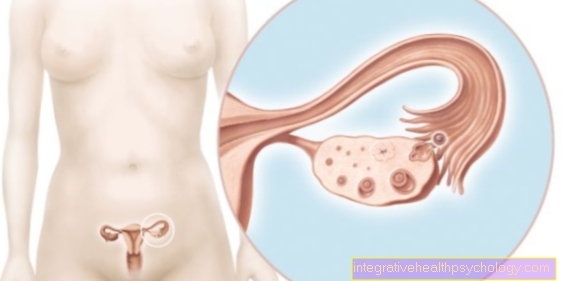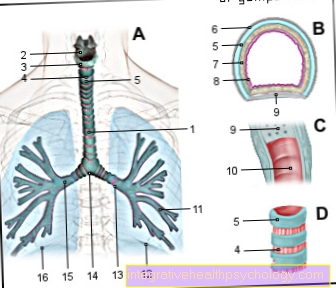What are the consequences of a chlamydial infection?
introduction
Chlamydia is a species of bacteria that can cause many different diseases. Although many people know chlamydia infection as a typical sexually transmitted disease, chlamydia can also trigger many other complaints.
Depending on the subspecies of the bacterium, infections of the upper respiratory tract and the lungs or diseases of the genital area and the genital organs can occur. The eyes can also be affected by a chlamydial infection.
Since the different chlamydia species can survive in very different regions of the human body, their transmission routes also differ from one another. While some chlamydia are transmitted via droplet infection and coughing, others are sexually transmitted pathogens. Depending on which organ system is affected by the infection, different consequences can occur. In general, a complication of a chlamydial infection is chronic inflammation of the affected organs.

These can be consequences of a chlamydial infection
-
Eye infection
-
Blindness
-
-
Infection of the genital tract
-
In women: uterus, fallopian tubes and ovaries
-
Adhesions and infertility
-
-
In men: inflammation of the epididymis and prostate
-
infertility
-
-
Chronic infections with adhesions
-
Fitz-Hugh-Curtis syndrome: inflammatory adhesions of the liver capsule
-
-
Respiratory infections
-
Sore throat, sinusitis
-
lung infection
-
You can find extensive information on the symptoms of chlamydial infection on our main page "Chlamydia infection - all important information at a glance".
infertility
Chlamydia infection is tragic, among other things, because in most cases it is symptom-free in both men and women. Nevertheless, it can cause serious damage, such as infertility.
Infertility after a chlamydial infection is transmitted by those bacterial species that cause diseases of the sexual organs and the genital tract. For example, it can be caused by the chlamydial strain Chlamydia trachomatis the following genital organs become infected:
- urethra
- Epididymis
- prostate
- uterus
- Ovaries
Due to the variety of chlamydial infections, both men and women can become sterile from the chlamydial infection.
In men, infection of the epididymis (epididymitis) and the prostate play a role in the development of infertility. Due to a chronic infection, the sperm can either no longer be formed properly or the vas deferens stick together as a result of the chlamydial infection. This can lead to male infertility or decreased fertility.
In women, the infertility associated with chlamydial infection often results in chronic inflammation and sticking of the ovaries. The fallopian tubes can also be affected by the infection and stick together due to the inflammation - this prevents the egg cell from migrating into the uterus if the ovaries are intact. As a result, the woman becomes sterile.
Since chlamydia is a sexually transmitted pathogen, both partners can become ill in a partnership, so that an unfulfilled desire to have children becomes more likely.
How long does it take to become sterile?
An exact point in time for the duration of the disease from chlamydia to infertility cannot be determined, as it depends on many individual physical factors.
There are people who get a chlamydial infection and can become infection-free again through the work of their immune system. The infection heals again without any therapy.
However, antibiotic therapy is a means Doxycycline in most cases much more useful. The longer the chlamydial infection lasts, the more likely it is that the infection will result in infertility. It is therefore advisable to treat the affected person as early as possible, and ideally also the current sexual partner.
lung infection
Respiratory diseases are caused by other strains of chlamydia. A distinction is made between these chlamydial species Chlamydia pneumoniae and Chlamydia psittaci.
As the name suggests, infection can be with Chlamydia pneumoniae lead to pneumonia. Most of the time, there is inflammation of the upper airways first. The lungs are then also affected by the infection. In most cases, Chlamydia pneumoniae cause what is known as atypical pneumonia. In contrast to the typical pneumonia, there is usually not such a sharp rise in fever, the symptoms are more like a flu-like infection. The cough is also rather unproductive, so no mucus is coughed up.
Also the Chlamydia psittaci can cause pneumonia. These subspecies are bacteria that are typically found in different birds (hence the name "psittaci" = parrot disease). The infection with Chlamydia psittaci is therefore one of the occupational diseases and particularly often affects occupational groups who work with birds. Here, too, the course can be very different, and atypical pneumonia is also common.
The therapy of pneumonia caused by different chlamydial species usually consists of the administration of the antibiotic Doxycycline over several weeks (one to three weeks).
Also read our main page "Chlamydial Infection of the Lungs".
Sore throat
While throat infections are most commonly triggered by viral infections, chlamydial infections can also lead to throat infections.
The two chlamydia species Chlamydia pneumoniae and Chlamydia psittaci are mainly transmitted from person to person or from birds to humans by droplet infection and are therefore the first to establish themselves in the mucous membrane of the nasopharynx. There they can lead to an inflammation of the throat, as well as a cold with a runny nose and possibly a sinus infection.
If the chlamydial infection sets in, bacteria can get into the deep respiratory tract and into the lungs themselves and thus cause pneumonia as a result of an inflammation of the throat caused by the chlamydial infection.
Intestinal inflammation
Intestinal inflammation is not one of the typical diseases that is triggered by a chlamydial infection. Infections of the eyes, the genital tract, the urinary tract as well as the airways and the lungs, which have already been described, occur more frequently.
Gastrointestinal complaints, however, can often be a side effect of using antibiotic therapy Doxycycline occur, which is used as a therapeutic measure for chlamydial infections. This is not a gastrointestinal infection in the strict sense, but rather an irritation of the mucous membrane of the gastrointestinal tract. The symptoms of this irritation disappear as soon as the antibiotic is no longer used and usually does not cause permanent damage.
Find out about other possible side effects of antibiotics at: "The Side Effects of Antibiotics".
Joint inflammation
Joint inflammation (arthritis) is one of the typical long-term consequences of a chlamydial infection. Most often it occurs as a result of an infection with Chlamydia trachomatis which can cause inflammation of the genital organs.
After the infection of the genital organs and urinary tract has passed, what is known as reactive arthritis develops. During the actual bacterial infection, the immune system forms antibodies that specifically attack the bacteria and thus ensure their elimination. Since the surface structures that attack these antibodies are very similar to the molecular structures of the joints, they unfortunately also attack the joints and lead to inflammation. Symptoms such as asymmetrically wandering joint pain and fever usually occur a few days to a few weeks after the actual chlamydial infection.
Blindness
Blindness after a chlamydial infection can be caused by the subspecies Chlamydia trachomatis be evoked. Both the subspecies Chlamydia trachomatis A to C and the pathogens D to K can establish themselves in the eye.
Chlamydia trachomatis A-C are transmitted either by flies or directly from person to person and lead to inflammation of the eye, which can lead to blindness without adequate treatment.
In contrast, the D-K pathogens are usually transmitted from the genital area to the eyes. Therefore, newborns from infected mothers have an increased risk of eye infections caused by chlamydial infections. If these are not recognized in time, this can lead to premature blindness of the child.
Eye infections caused by Chlamydia trachomatis are treated with antibiotic eye ointments, among others with Floxal.
Are there also cases without long-term effects of a chlamydial infection?
Chlamydial infections do not necessarily have to be accompanied by consequences. If they are discovered early and treated appropriately, consequential damage can be prevented.
The therapy consists of the administration of the antibiotic Doxycycline over several weeks. If the chlamydial infection can be contained in this way, consequences rarely occur.
On the other hand, the longer the chlamydial infection lasts untreated, the more likely secondary diseases such as chronic inflammation and thus the loss of function of the affected organs become.



-cola.jpg)

























